|
|
Post by Packer on Oct 4, 2014 18:48:53 GMT -5
I just got mine today. I give it an 8 out of 10...
Pros:
Loksound sounds awesome Pretty heavy Beacon works out of the box (and looks really good for an LED) Dual Speakers Comes with Kadees
Cons: Gaping hole between the trucks and the frame Front coupler is very hard to remove (trimming the coupler box seems to help) The shim for the coupler boxes that go inside the shell like to fall inside the unit Motor looks cheap Rear light shines through the frame (like the front of an Athearn BB F-unit) The horn stand provided isn't 100% accurate for a SP&S BN unit. It's close enough for me...
Might just be my unit, QC doesn't seem to be much anymore: A touch of red paint on the front numberboard One of the front MU hoses was in the bottom of the box when I pulled it out
Here's some pics: 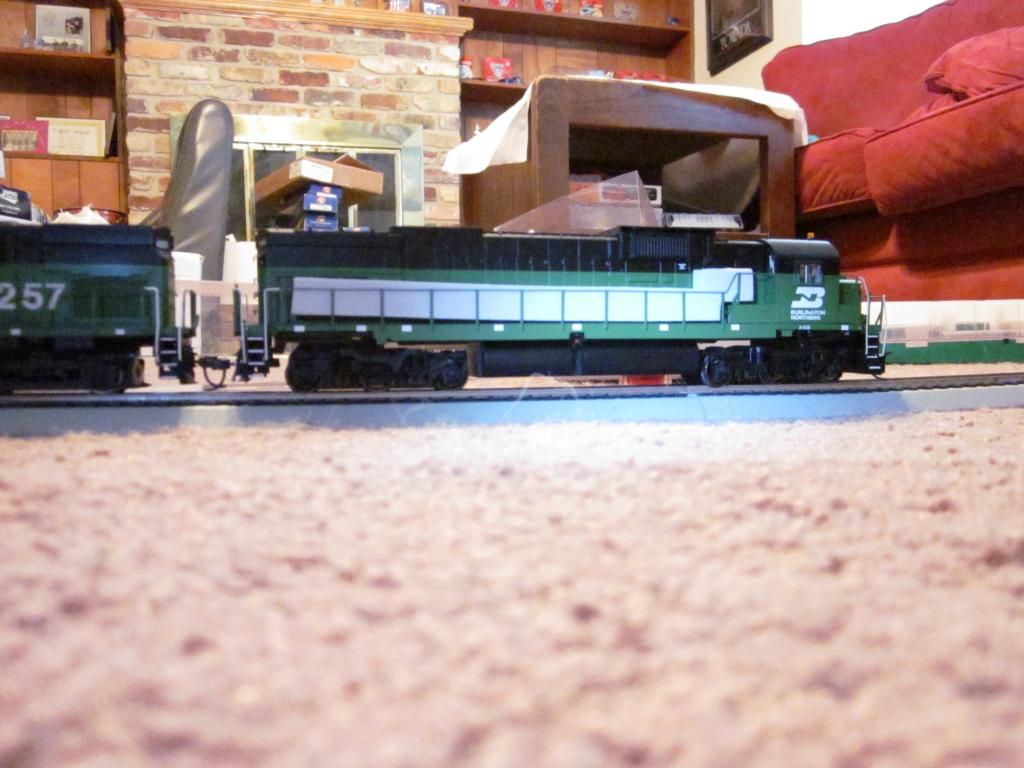
Coupled to one of my C425s, decks are level, but there is the gap between the trucks and frame. I noticed the wheel on the ground after I took the pic.
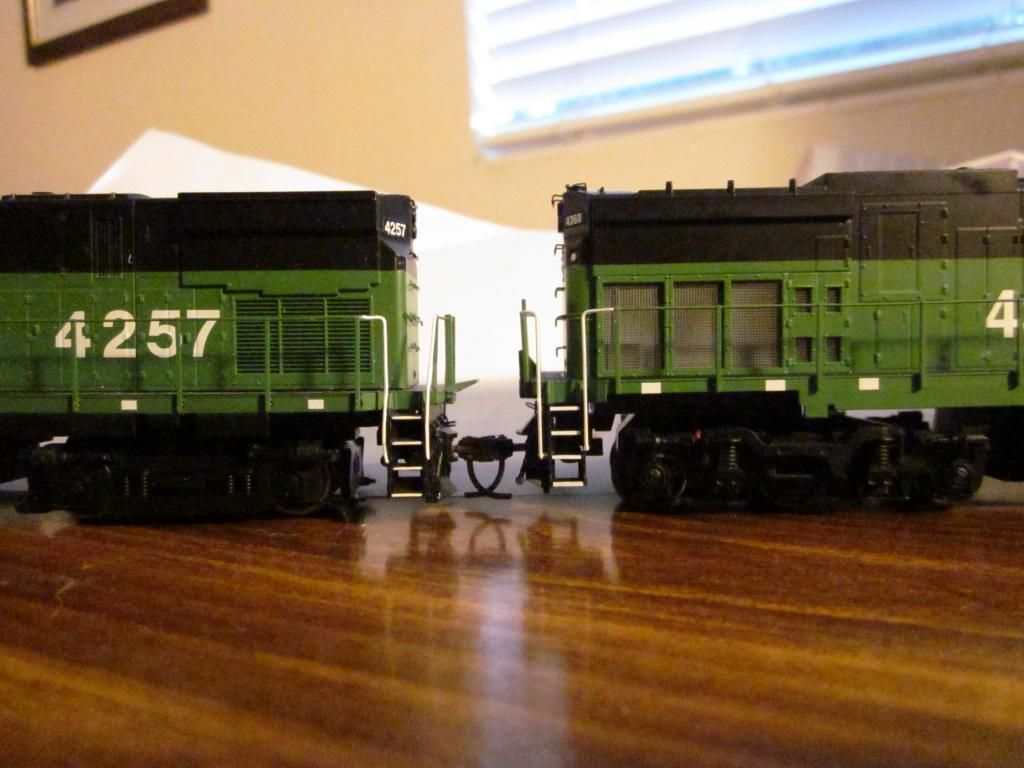
Coupled to the C425 again

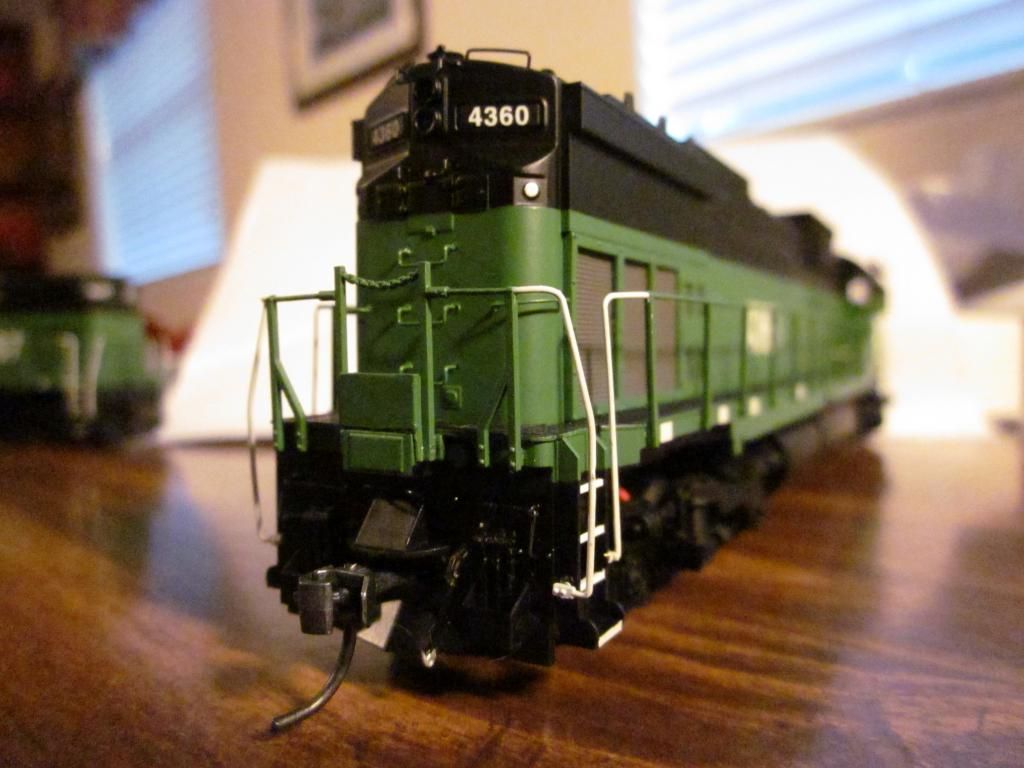
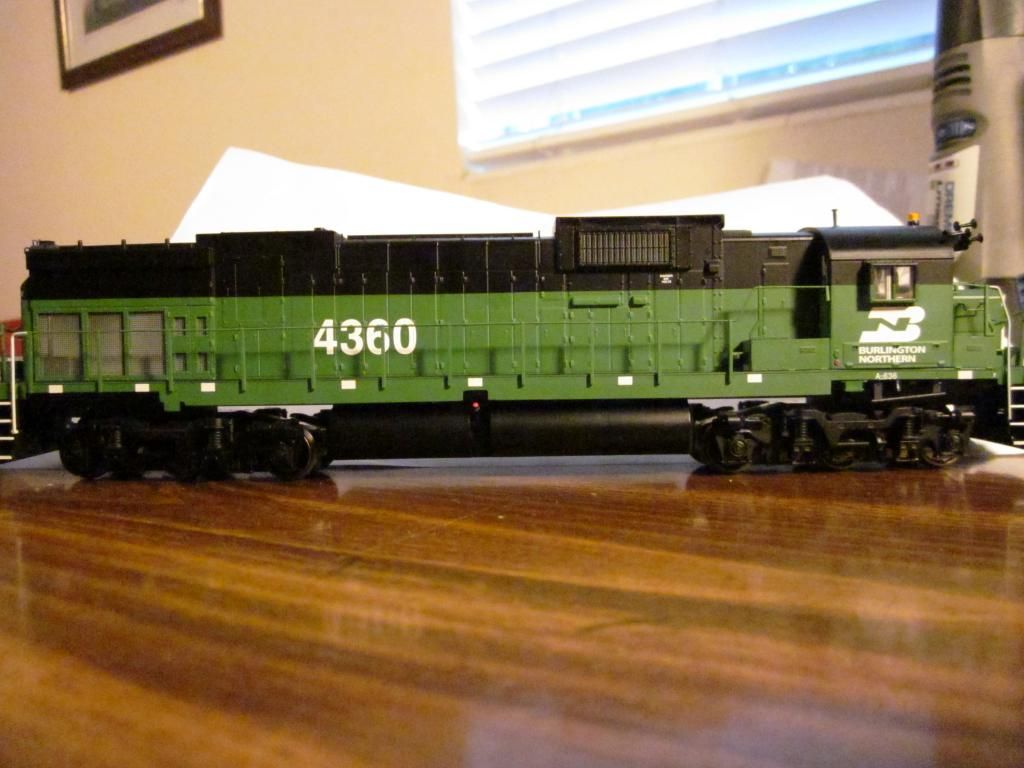
Now I really want to finish off my C425s*...
*Need plows, beacons, correct horns, and antennas.
Also, not to self: Throw this camera out. I can't get a good pic with it. |
|
|
|
Post by Packer on Oct 7, 2014 22:01:15 GMT -5
Here is a picture of my Bowser C636 coupled to a Bowser C628: 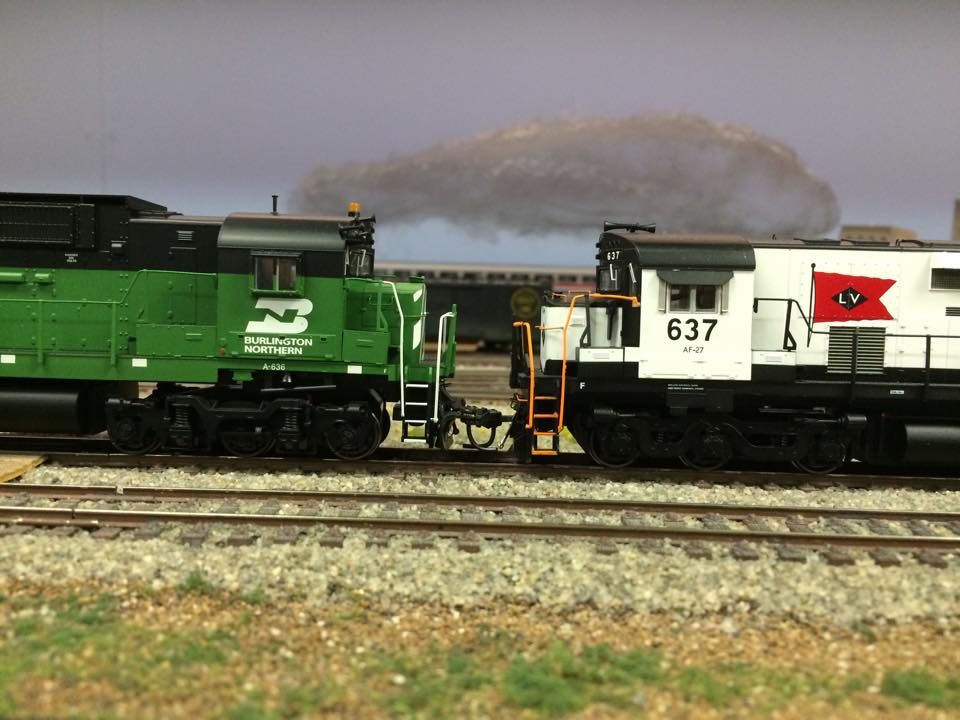 The C636 sits a good bit higher. But according to some stuff I am finding online, this may actually be accurate: www.trainorders.com/discussion/read.php?3,3535347 www.trainorders.com/discussion/read.php?3,3537945 Notes from above link: 1. The BN C636 had a deck height of 6' 2. Alco C630s riding on High-ad trucks were 5" taller 3. C636s have a 5000 gallon tank versus the C630's 4000 gallon tank. Anyone here well-versed on ALCOs? |
|
|
|
Post by ChessieFan1978 on Oct 7, 2014 22:22:00 GMT -5
Wow that fuel tank sure looks a little high off the rails.
|
|
|
|
Post by stevef45 on Oct 8, 2014 3:55:10 GMT -5
are the frames totally different? i mean that is a huge difference in height, i mean it looks like it can go offroading its that tall.
|
|
|
|
Post by iomalley on Oct 8, 2014 9:54:32 GMT -5
The C636s were noticably higher off the rails, Bowser did this correctly. Alco used a thicker frame on the 636s.
Bowser may have just used the C630 fuel tanks, and they may not be proportioned correctly.
|
|
|
|
Post by Packer on Oct 8, 2014 13:32:28 GMT -5
The C636s were noticably higher off the rails, Bowser did this correctly. Alco used a thicker frame on the 636s. Bowser may have just used the C630 fuel tanks, and they may not be proportioned correctly.
That's what I'm beginning to think. I could fix the gap by attaching some .125 x .05 material to the underside of the frame.
As for the fuel tank, they did use the C630 tank. The C636 tank was bigger.
Wonder if I can find dimensions of the 5000 gallon tank used on the C636
|
|
|
|
Post by iomalley on Oct 8, 2014 16:40:05 GMT -5
It also looks like Bowser didn't modify the steps. The 'math' would have been changed on the real thing to account for the extra height, so the bottom step remains at the proper height off the rail, and the difference is divided amongst the other steps. MLW did it with the big Ms, not sure ALco did.
|
|
|
|
Post by analogbeatmaker on Oct 8, 2014 23:44:24 GMT -5
I must agree that the body looks too high off the trucks and the fuel tank looks too high off the rails. Here is the link to a thread on this site that has really great detail pics of this type loco. dieseldetailer.proboards.com/thread/4381/alco-c636-detail-photos You can see the spacing looks very different from the proto to the model. However, I wouldn't know where to start to tell you how to attempt fixing the issue. |
|
|
|
Post by Packer on Oct 13, 2014 22:09:27 GMT -5
I made a modification to the bottom of the frame of my C636 to hide the gap between the trucks and the frame: A piece of .06 x .125 filler for the gap in the undersized channel for the frame: 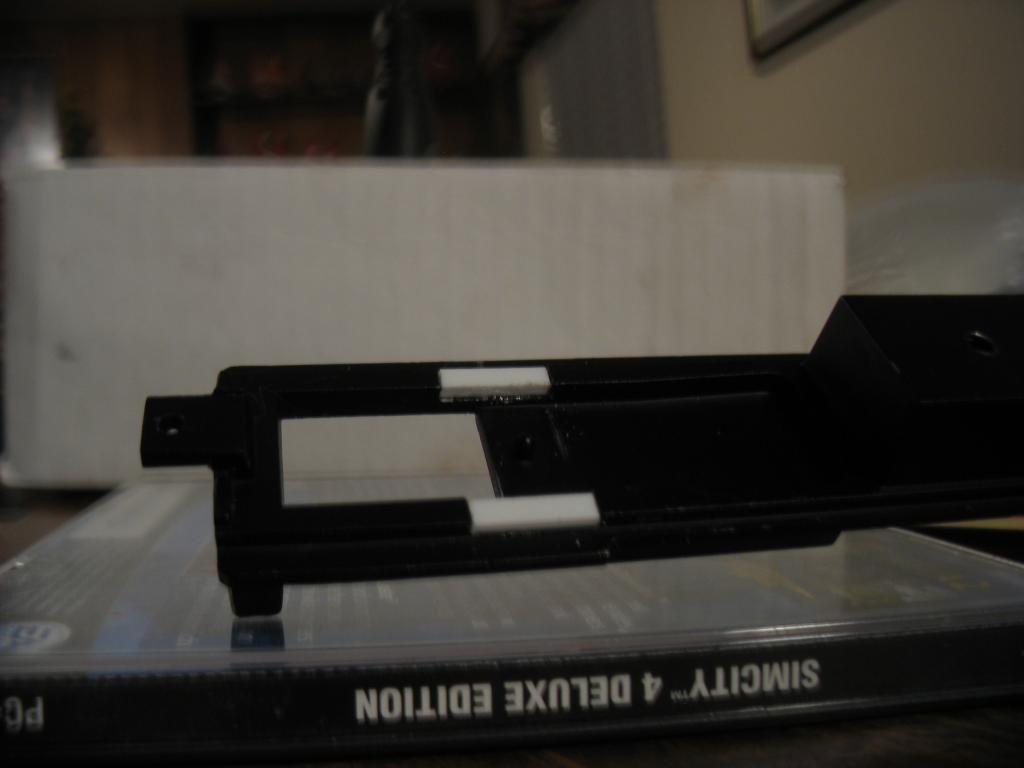 Then a piece of .06 I-beam was glued to the frame. I made it a U-channel towards the end to clear a notch in the frame: 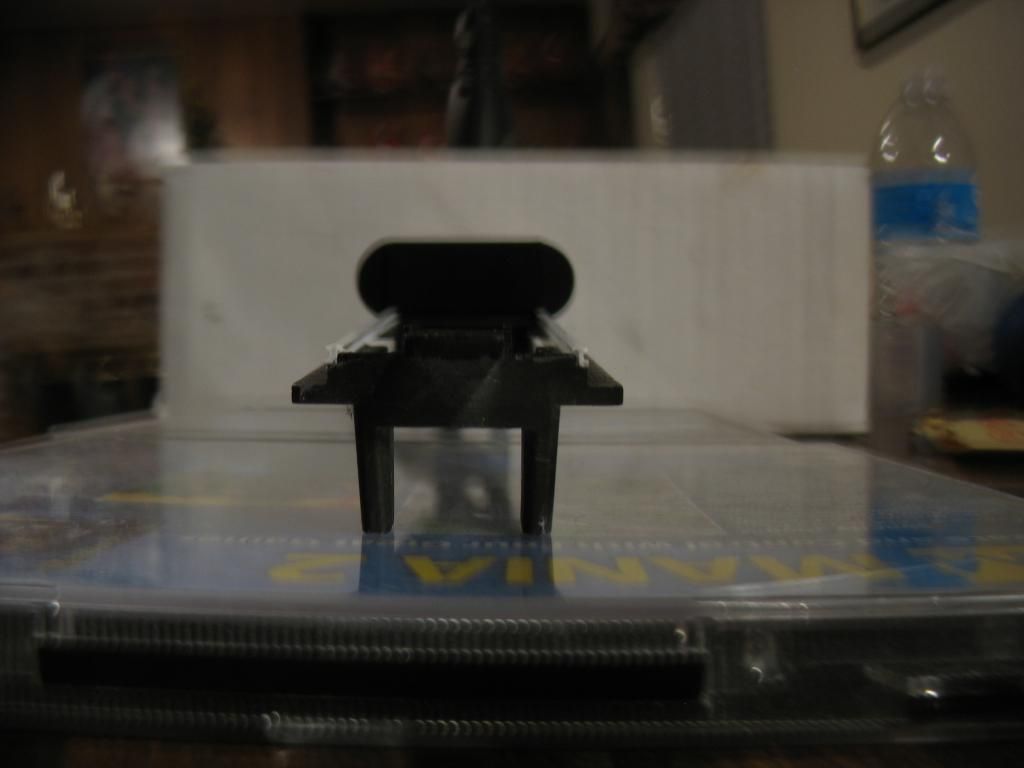 A test of truck clearance. As long as there are no sudden horizontal kinks in the track on a very tight turn, it should be fine: 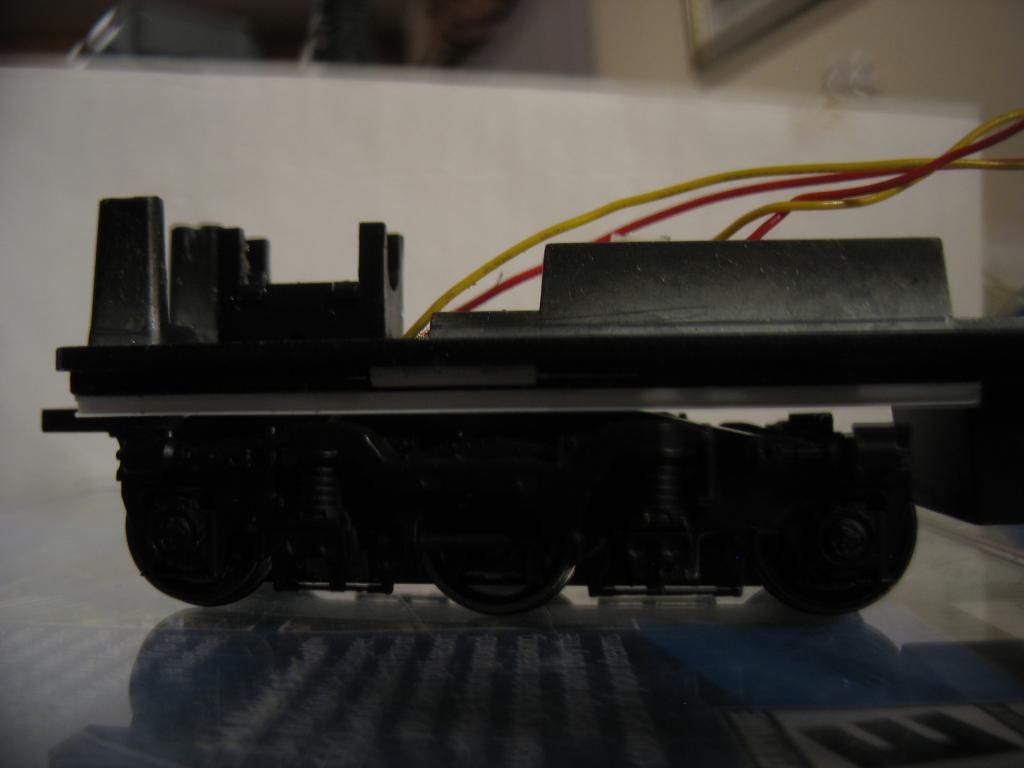 Here are pictures of the 4 corners: 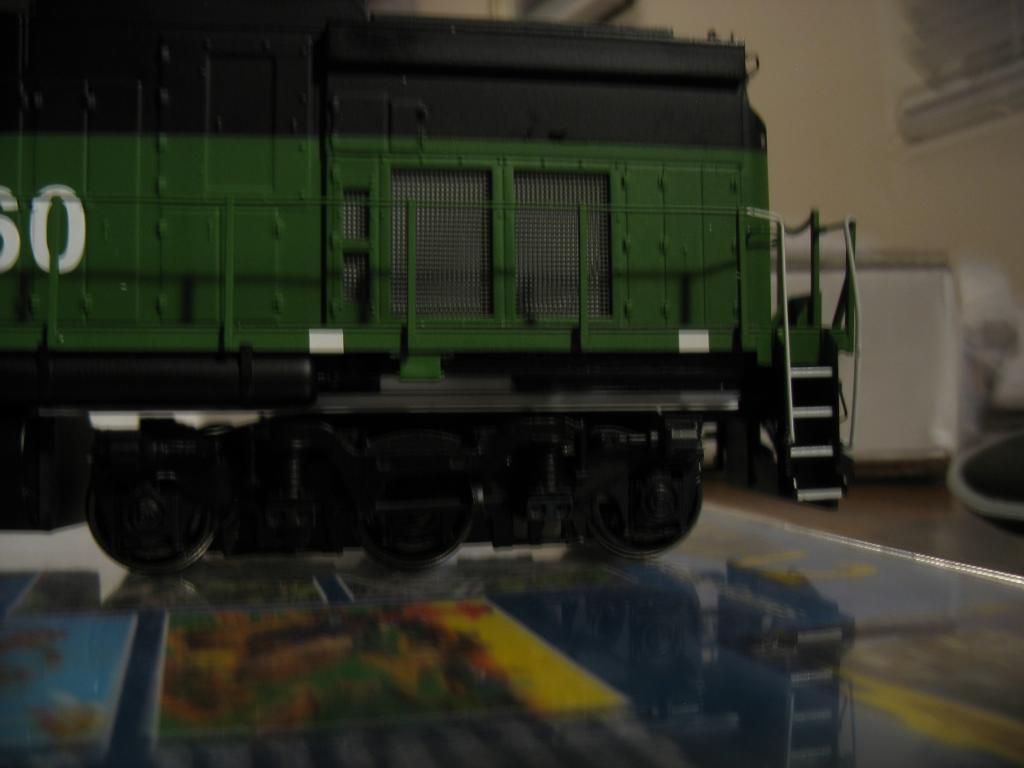 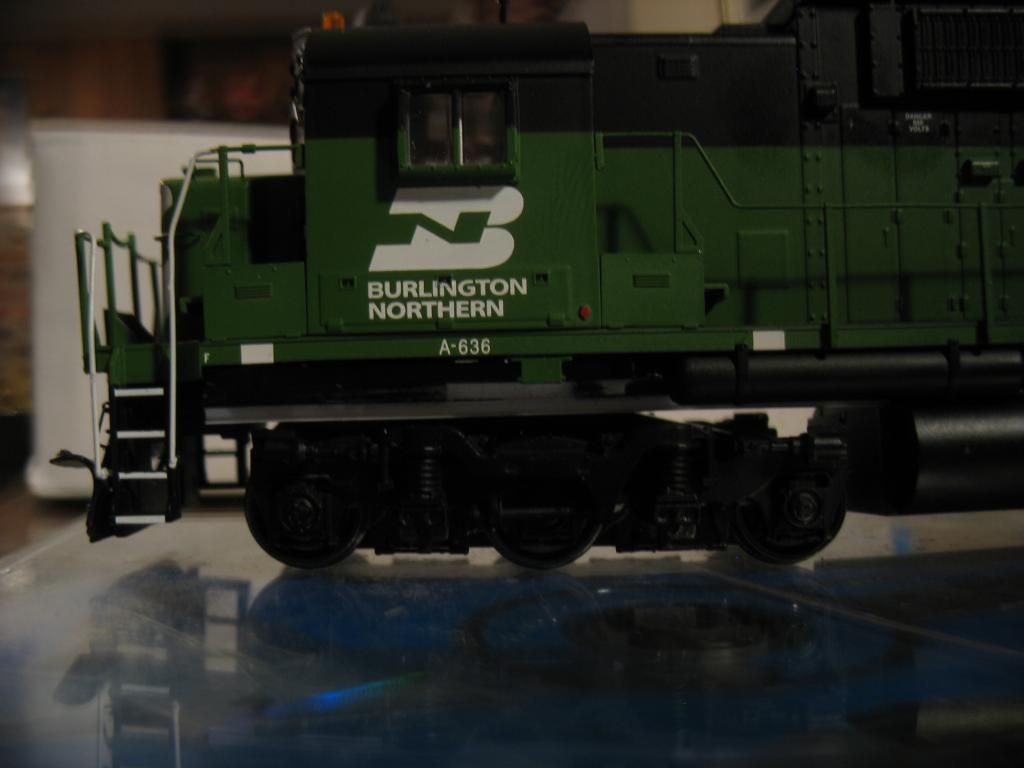 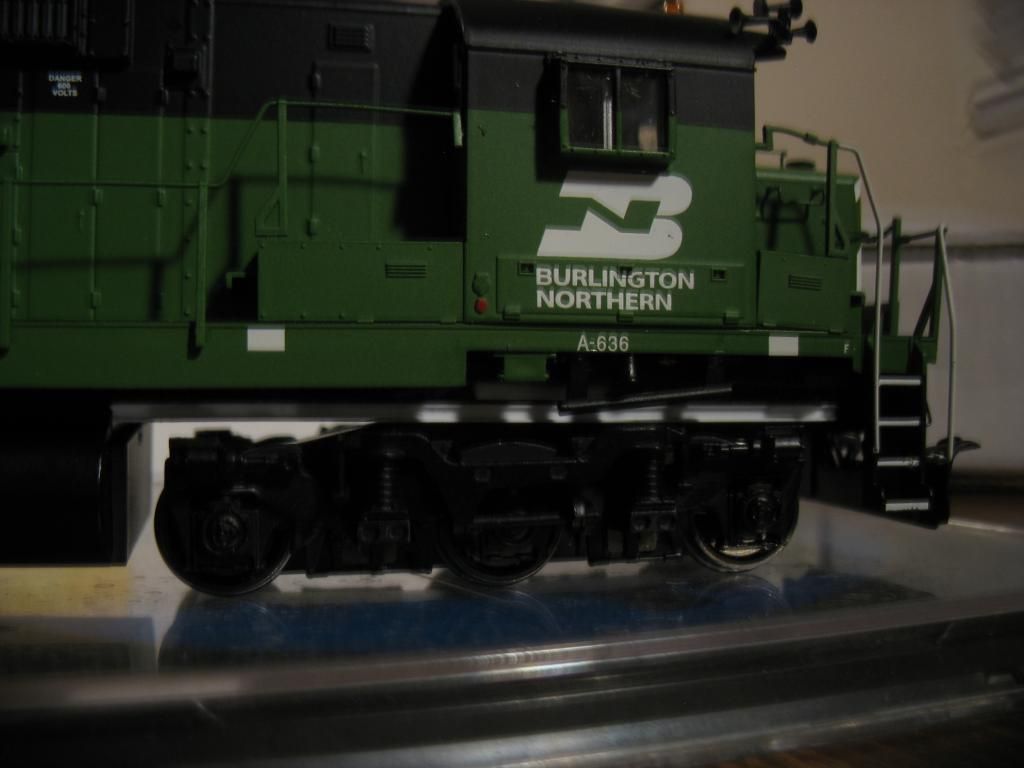 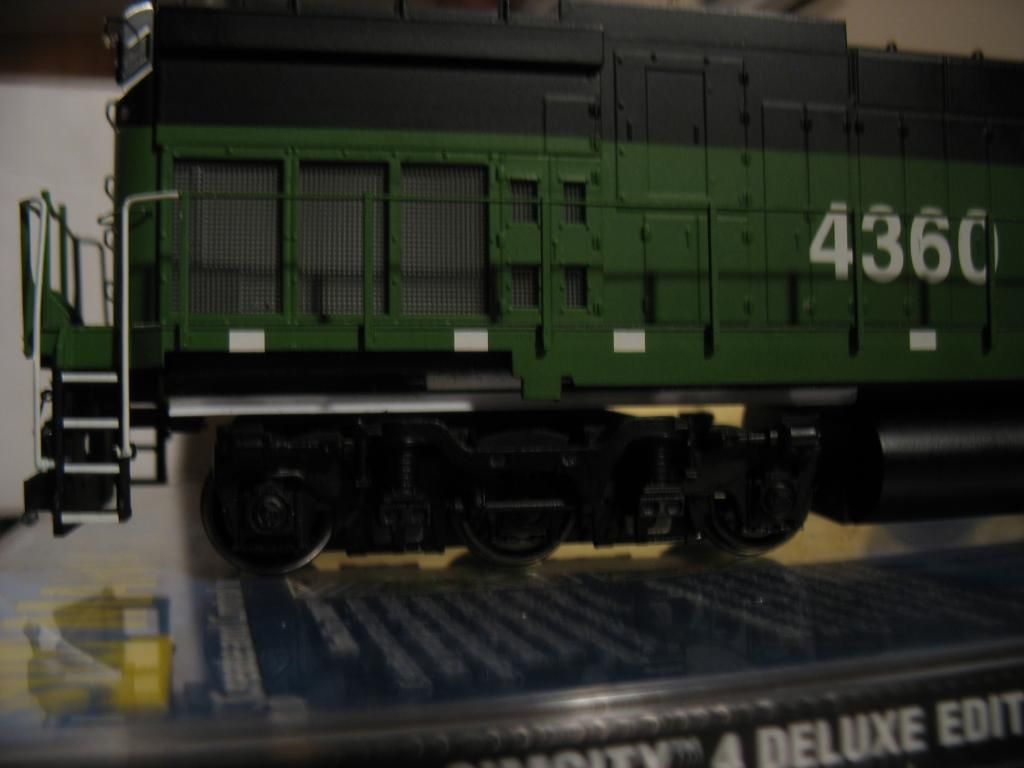 Paint will come tomorrow |
|
|
|
Post by MitchGDRMCo on Oct 16, 2014 7:31:14 GMT -5
If the sideframes are the correct size are they mounted so the bearing caps are in the center of the wheels behind?
|
|
|
|
Post by Packer on Oct 16, 2014 11:39:12 GMT -5
gdrmco, They are mounted that way. but the hole in the back of the side frames is rather large. Luckily they are ABS (according to Bowser's page) so one might be able to cut the mounting pegs off and raise it.
rnjmgo, That's really inresting right there. Although it appears the model may be at a slight tilt to the camera towards the top compared to the prototype. Of course there may be a difference between a SP&S/BN and a PC/CR C636
Edit: I found my 1972 BN annual with the C636 as the featured loco. It shows a height of 15' 1.25". In HO that equates to 52.85591274397245 mm*. I measured from the top of the rail to the rood of the cab on mine and got just under 53 mm. No deck height is given...
* 15 x 12 = 180 + 1.25 = 181.25 / 87.1 = 2.080941446613088 x 25.4 = 52.85591274397245 |
|
|
|
Post by T on Oct 16, 2014 12:13:46 GMT -5
Can't wait 'til they produce an N-SCALE Version.
Tom
|
|
|
|
Post by iomalley on Oct 16, 2014 12:52:23 GMT -5
Be careful with Trainiax drawings, they shouldn't be used as a be-all resource for accurate drawings. Packer, what kind of ruler do you have that has the accuracy of 16 significant figures in mm!!!!  |
|
|
|
Post by Packer on Oct 16, 2014 14:19:10 GMT -5
Sean, the drawing I used to get my actual height is in my 1972 BN Annual. That was way before trainiax, lol. The best ruler I have only goes down to 1/64 or 1/32 increments. I just don't know where it is cause it's kinda small. lol
|
|
|
|
Post by Packer on Oct 16, 2014 19:09:11 GMT -5
Just curious, what size wheels did the C636s ride on?
It may be an illusion, but the model's wheels seem a tad smaller than the real one
|
|
|
|
Post by WC#3026 on Oct 19, 2014 18:09:11 GMT -5
I just got the same unit. I could not find a prototype photo with the A636 under the cab. I just assume this is an ALCO identification?  The gap under the fuel tank is the biggest visual that make me look harder for other issues, as mentioned above. I hope that Bowser comes through and corrects the fuel tank in the future. Ok...I found the answer:Burlington Northern Railroad C-636 4366 in the dead line at Cicero, Illinois on an unknown day in September 1980, Kodachrome by Chuck Zeiler. This locomotive was built as Spokane Portland & Seattle C636 340 delivered in November 1968 (c/n 6010-01) and was retired in August 1980 as BN 4366. The BN stenciled the model designation on the frame as A-636. The SP&S received a total of 10 C636's in two orders, the first order for six (SP&S 330-335, BN 4360-4365) was completed in December 1967 - January 1968, and the second order for four (SP&S 340-343, BN 4366-4369) was delivered in November 1968.
www.rrpicturearchives.net/showPicture.aspx?id=1279844
Now...how to build the knuckle holder under the conductor side of the cab??? |
|
|
|
Post by prescottpete on Oct 24, 2014 15:50:44 GMT -5
I have both the Bowser and Oriental C-636s; and comparing them they are pretty much identical in height off the rail, the Bowser is probably only slightly higher (probably the "inch" Bowser talks about). BUT, Bowser got something else wrong as (1). the bottom step and snowplow sit about 6 inches too far above the railhead (the Oriental is good). This is easily seen looking at side-view photos of the prototype where the axle journal box lines up BETWEEN the bottom two steps; whereas Bowser has it lining up centered on the bottom step. The HO engineer would need a step-ladder to get up on his loco! (2). the Bowser side walkways are several inches higher off the railhead compared to the Oriental, the side sills below the walkway are several inches thinner than the Oriental, and the fuel tank is small and mounted higher than the Oriental. ALL of these factors contribute too much "air-space" when viewing it from the side and making it look wrong compared to the Oriental AND the prototype. You can see the gap the Bowser has above the truck side-frames compared to the Oriental and the prototype! (3). It has a very weak motor and too much "glue-like" lube grease in the gearboxes which make it weak and slow. Cleaned out their grease and used better grease seems to help. Bowser has admitted it has a weak motor and will have a better one in later runs. I have to run mine with my P2K IC U30Bs in order to get a decent train around the layout; which also shows how high the lower walkway step and snow plow are off the rail as the U30B is correct! Has anyone compared the model to the real thing to verify that Bowser is indeed WRONG about their claims to be correct height?
Peter Arnold
|
|
|
|
Post by iomalley on Oct 25, 2014 8:44:53 GMT -5
How can you use 2 photos, one of the prototype and one of the model to overlay? Each camera that took the picture has a lense with differing distortions creating a pin cushion effect that makes it next to impossible to overlay. A quick look of your animated gif shows you're railheads don't match.
Must we bash Bowser to this degree? This is the detail detailer, if its not accurate fix it! The silent minority has either started running their C636s with pleasure, or dismantled them to tweek. Bowser used some license to keep their costs down, such as reusing ladder and fuel tank moulds from C630 runs.
|
|
|
|
Post by enginseer on Oct 25, 2014 9:14:54 GMT -5
I'll have to withdraw my statements concerning the sizes of the side sill, ladders, and brake cylinders. My fuel tank comments I leave standing. Since that post I've made a more in-depth side-by-side comparison using the 2 photos cites above and added a Trainiax elevation to the set. I rotated the photos so the railheads were flat horizontally, scaled out all the images to HO scale (87.1:1) and laid them out side-by-side on my graphics software being careful to keep the images as-is proportionally. I lined up the railhead and cab roofs of all 3 images and the results were: Again, everything pretty much matches to a pretty fine tolerance except the HiAd sideframes - weird thing is they only "droop" as they are mounted, about scale 1" or so. So comparing the vertical measurement of the sideframe from the bottom of the yoke to the top of the squared area behind the brake cylinder indicated the sideframe casting may be somewhere between 3.88" to 5.1" short of what the proto photo and the drawing indicate it should be. That "stretch" would bring the sideframe top just about where looks like it ought to be. Everyone seems to be talking about raising or lowering things between the frame and truck. I think someone needs to take a caliper to one of the sideframe castings.  You know, in looking at these two photos I can definately see a scaling issue with the trucks. The sideframes seem much more "vertically challenged" than those found on the prototype. As if they were "squashed" somewhat without adding any bulk in doing so. Horizontally the trucks seem ok for the most part, but the spring is far thinner than the prototype. Overall I think the horizontal dimensions are ok (other than the spring diameter), but the vertical elements of the main frame seem shrunken. At least for the top 1/4 of the truck. |
|
|
|
Post by prescottpete on Nov 3, 2014 14:17:23 GMT -5
You are wrong, your above photos even show how the ladders and plow are too far off of the rail. The prototype journal center is between the two bottom steps; whereas on the Bowser the bottom step is lined up with the center of the journal, a difference of about six inches or so. Even your eyeball can see that. I also found an Alco drawing confirming my statement in the Diesel Era "Alco Century Series - Vol two - six-axle models", the center of the journals line up in the center of the two bottoms steps, NOT even with the bottom step. Bowser blew it and made the truck bolster too thick causing the huge gap under the steps and plow. They obviously knew about it and chose to make that silly filler block to make the couplers line up; but that messed everything up!
They could fix the problem by lowering the top of the gear box casting (or we can by shaving it, but we shouldn't have to fix their mistake!). The new fuel tank will help, but the step height will still be wrong. AND then there are the bad gears and WEAK motor!!
Peter Arnold
|
|